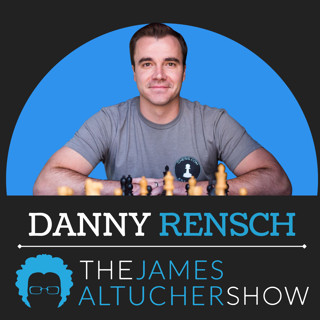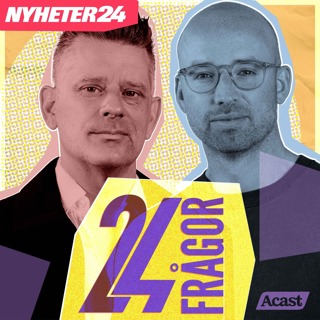
Dark Squares: Danny Rensch on Chess, Cults, and Finding Purpose
A Note from JamesThis might be the most insane chess story I’ve ever heard—not even really a chess story, but a cult story. It’s wild, intense, and ultimately inspiring. Danny Rensch grew up in a cult in Arizona. At just 10 years old, the cult leader noticed his chess ability, took him away from his parents, and he wouldn’t see his mother again for a decade.I first heard Danny’s story when we met at Norway Chess a year and a half ago. Over dinner, he told me pieces of what would become his book Dark Squares: How Chess Saved My Life. I worried later that I’d pushed him into podcast mode before he was ready, but Danny said he was actually grateful for the chance to practice sharing his story out loud. Now, with his book out, he’s ready to open up fully.Episode DescriptionDanny Rensch, Chief Chess Officer at Chess.com and author of Dark Squares: How Chess Saved My Life, shares the extraordinary story of how growing up in a cult shaped his childhood, his chess career, and his path to resilience.From being separated from his mother at age 10, to navigating indoctrination, hierarchy, and trauma, Danny explains how chess became both his prison and his salvation. This conversation is about more than chess—it’s about control, identity, purpose, and how to reclaim your life from the stories others force on you.What You’ll LearnHow a cult leader used chess as propaganda—and how Danny reclaimed the game as his own.The three pillars of cult life Danny experienced: like vibration, the process, and purpose.Why vulnerability and storytelling can be healing—but also how they can be weaponized.The psychological toll of being told your “purpose” at age 12—and how to build a new one.What Danny learned about resilience, family, and community after leaving the cult.Timestamped Chapters[02:05] A Note from James: introducing Dark Squares[02:34] Danny’s childhood in a cult and separation from his mother[03:40] How Danny first shared his story with James in Norway[05:09] Learning to talk about trauma without fear of judgment[07:00] The challenge of context—why cult stories get misunderstood[08:20] Headline version: growing up in the Church of Immortal Consciousness[10:18] Cult hierarchy, trance teachings, and the Shelby School chess team[12:12] Was it spiritual belief—or a scam?[14:15] The role of Trina and Steven Camp, cult leaders and channelers[17:00] How hierarchy and “like vibration” destroyed marriages and families[23:00] The three pillars: like vibration, the process, and purpose[32:28] “The process”: group confession, alcohol, and weaponized vulnerability[41:54] “Purpose”: how chess became Danny’s imposed destiny[46:41] What it meant to be told at 12 that chess was his life’s purpose[50:18] Family secrets, hidden paternity, and the dangers of indoctrination[55:20] Processing trauma as an adult and writing Dark Squares[02:05] A Note from James: introducing Dark Squares[02:34] Danny’s childhood in a cult and separation from his mother[03:40] How Danny first shared his story with James in Norway[05:09] Learning to talk about trauma without fear of judgment[07:00] The challenge of context—why cult stories get misunderstood[08:20] Headline version: growing up in the Church of Immortal Consciousness[10:18] Cult hierarchy, trance teachings, and the Shelby School chess team[12:12] Was it spiritual belief—or a scam?[14:15] The role of Trina and Steven Camp, cult leaders and channelers[17:00] How hierarchy and “like vibration” destroyed marriages and families[23:00] The three pillars: like vibration, the process, and purpose[32:28] “The process”: group confession, alcohol, and weaponized vulnerability[41:54] “Purpose”: how chess became Danny’s imposed destiny[46:41] What it meant to be told at 12 that chess was his life’s purpose[50:18] Family secrets, hidden paternity, and the dangers of indoctrination[55:20] Processing trauma as an adult and writing Dark Squares[63:28] Early aptitude signs: multiplication tables and ADHD focus[65:22] Childhood acting dreams and practicing “the eyebrow lift”[72:24] The most painful mother–son conversation: loyalty to the cult vs. family[73:39] Giving away belongings before leaving home—grieving his mother alive[87:31] Medical breakdown, ears exploding, and a failed chess career[88:16] Bedridden but discovering the internet: early lessons in tech and online chess[89:16] Buying domains, teaching online, and meeting Eric and Jay[114:25] On Magnus Carlsen: confidence, health, and the “Great White Shark” mindset[116:20] Chess.com and the post-COVID boom: making a living beyond world championshipAdditional Resources📖 Dark Squares: How Chess Saved My Life by Danny Rensch🌐 Danny Rensch on Chess.com🎥 Searching for Bobby Fischer (1993 film)See Privacy Policy at https://art19.com/privacy and California Privacy Notice at https://art19.com/privacy#do-not-sell-my-info.
24 Sep 2h 1min

Finding Connection in a Divided World with 'Super Communicator' Charles Duhigg
A Note from JamesI’m really concerned about the level of discourse in this country. It’s almost a cliché to say that now, but especially after the Charlie Kirk assassination, the division feels overwhelming. I even got invited to speak at the Oxford Union—the most prestigious debate society in the world—but ultimately declined because I didn’t like how the whole situation was being handled.I can’t stand when anyone celebrates a death. Regardless of politics, it disturbs me. And every day, my social media feed is filled with more division and hatred. So I wanted to talk with Charles Duhigg. He wrote Super Communicators (now out in paperback) about how to actually connect with people in a world that seems torn apart. Even in a short conversation, I learned so much from him—things that made me think in new ways.Episode DescriptionPulitzer Prize-winning journalist and bestselling author Charles Duhigg (Super Communicators, The Power of Habit) joins James to explore how we can talk to each other in an age of polarization. From tragic political violence to everyday disagreements with family and friends, Charles explains why humans are wired for connection, how to ask better questions, and what it takes to turn conflict into understanding.This episode is a practical guide to becoming a better communicator—especially when the stakes are high.What You’ll LearnThe three types of conversations—emotional, practical, and social—and why mismatched conversations cause breakdowns.How to ask “deep questions” that uncover values and experiences, not just surface facts.Why mirroring, looping, and listening carefully make people feel truly heard.How to handle anger and cliches with curiosity instead of combat.Why disagreements don’t destroy democracy—bad communication does.Timestamped Chapters[03:08] James on division, Oxford Union, and why he turned down an invitation[06:06] Why James brought Charles Duhigg on the podcast[07:00] Political violence, polarization, and clashing conversations[10:42] What made Charlie Kirk an effective communicator[12:21] Communication as connection, not just information[13:21] Do both sides have to want connection?[15:20] Congress, partisanship, and performative politics[19:36] How “deep questions” build trust and reveal values[21:10] James on why he podcasts—and Charles’s analysis[23:39] Social reciprocity and feeling closer through vulnerability[24:23] History shows the value of disagreement done right[26:00] Why we reward bad behavior—and how to stop[27:09] James on gun control neutrality and frustration[29:00] Parenting lessons applied to political disagreements[30:00] “When you’re furious, get curious”[31:53] Moving past cliches by asking about personal experiences[33:08] Admitting confidence levels in arguments[34:19] Is Charles optimistic about America’s communication future?[34:50] A challenge for listeners: ask someone you disagree with “why does this matter to you?”[36:09] Closing thoughts: Super Communicators now in paperbackAdditional Resources📖 Super Communicators by Charles Duhigg📖 The Power of Habit by Charles Duhigg🌐 Charles Duhigg’s websiteSee Privacy Policy at https://art19.com/privacy and California Privacy Notice at https://art19.com/privacy#do-not-sell-my-info.
20 Sep 41min

Inside the Cartel: The Longest Undercover FBI Operation with Martin Suarez and Ian Frisch
A Note from JamesThis is a crazy story. Martin Suarez holds the record for the longest continuous undercover assignment in FBI history. He went undercover as a cartel drug lord—smuggling billions of dollars’ worth of cocaine while posing as “Manny.” At one point, the story even starts with a gun to his head, convinced his cover was blown.The book Inside the Cartel: A True Crime Tale of Espionage, Undercover Operations, and a War Against Billionaire Drug Lords—co-authored with journalist Ian Frisch—captures it all. Martin’s voice may be difficult to catch at times because he’s been battling ALS, but every word is worth hearing. Ian also joins to help tell the story. This conversation had me on the edge of my seat.Episode DescriptionFormer FBI agent Martin Suarez spent more than a decade living undercover inside Colombian cartels. Known to the underworld as “Manny,” he laundered money, smuggled cocaine, and survived assassination attempts—all while secretly working for the U.S. government.In this episode, James sits down with Suarez and his co-author Ian Frisch to explore how an ordinary Navy veteran became the FBI’s ultimate undercover agent, why deception works in high-stakes negotiations, and what lessons from cartel infiltration apply to everyday life.What You’ll LearnThe psychological techniques Martin used to maintain his cover for years inside violent cartels.How undercover work creates “alternate realities” to control narratives and shift blame.Why confidence and self-belief are critical in negotiation, business, and personal life.The role of deception and patience in both undercover work and real-world persuasion.How Martin and his family managed the risks and sacrifices of a life lived undercover.Timestamped Chapters[03:00] A gun to the head: the moment Martin thought his cover was blown[07:00] Surviving a cartel hitman[10:00] From Navy to FBI: the start of an undercover career[12:00] Why Martin was the “perfect” undercover agent[14:00] Smuggling versus intelligence gathering: the FBI’s strategy[16:00] How to move cartel shipments without breaking cover[18:00] The art of deflecting blame and creating alternate realities[22:00] Cartel power and control in Colombia[23:00] U.S. government ties and the Iran-Contra era[25:00] Using FBI agents as “girlfriends” to gather intelligence[27:00] Facing long-term risks—and the bigger battle with ALS[30:00] Marriage, trust, and sacrifice during undercover life[32:00] Art theft undercover operation in Europe[36:00] Fooling even the CIA with a perfect legend[41:00] How legends are built in the digital age[44:00] Negotiation, seduction, and cartel psychology[45:00] Ian’s lessons on confidence and self-convincing[47:00] Applying undercover strategies to everyday life[49:00] The role of greed in cartel decision-making[50:00] Marriage, grounding, and long-term support[51:00] Are cartel leaders truly evil—or just highly educated?Additional Resources📖 Inside the Cartel by Martin Suarez and Ian Frisch✍️ Ian Frisch’s journalism and other workSee Privacy Policy at https://art19.com/privacy and California Privacy Notice at https://art19.com/privacy#do-not-sell-my-info.
17 Sep 59min

How to Focus Like a Nobel Prize Winner with Prof. Brian Keating
Episode DescriptionJames sits down once again with cosmologist Brian Keating—longtime friend of the show and author of Into the Impossible: Focus Like a Nobel Prize Winner. In this candid conversation, they challenge each other’s views on focus, curiosity, and the trade-offs of staying in your lane. Brian shares behind-the-scenes lessons from interviewing Nobel Prize winners, the thinking behind his new “Keating Test” for AI, and why communication matters as much as discovery in science.This episode isn’t about self-help clichés. It’s about real-world insights you won’t hear anywhere else—whether it’s why guarding your time is the most important skill, how to use flow states to sharpen your career, or why great breakthroughs depend on questioning the work of those who came before.What You’ll LearnWhy Brian created the “Keating Test” as a new measure for true artificial intelligenceHow Nobel Prize winners balance intense focus with curiosity across disciplinesWhy communication skills matter as much as scientific discovery for lasting impactHow to guard your time from “time bandits” and apply the power of saying “no”Practical ways to find your lane—or combine lanes—while still pursuing flow and masteryTimestamped Chapters[02:00] The Keating Test: AI, free will, and the act of survival[06:00] Humor, history, and reclaiming the “worst joke ever told”[08:00] Friendship, TEDx, and 11 years of conversations[09:00] Lessons from Nobel Prize winners: beyond self-help habits[10:00] Publishing with Scribe/Lioncrest and connections to James and David Goggins[12:00] Into the Impossible, Volume One: why distilling Nobel wisdom matters[13:00] Imposter syndrome, Alfred Nobel, and Volume Two’s focus[15:00] Donna Strickland, LASIK, and the power of saying no[18:00] Stay in your lane—or widen it? A debate on mastery and curiosity[23:00] Newton, Pascal, and the discipline of sitting in a room[26:00] Regrets, diversification, and finding flow[28:00] Crystallized vs. fluid intelligence in the age of AI[31:00] The importance of novelty—and the Lindy test[35:00] Math, reality, and the unreasonable effectiveness of ideas[38:00] Teaching quantum computing: bridging theory and life skills[43:00] From cryogenics to code: skills that outlast AI[47:00] Why communication defines success in science[50:00] Doing things that don’t scale: relationships, meteorites, and networks[52:00] The missed opportunities of office hours—and how to build relationships[54:00] Reading theses, genuine curiosity, and non-scalable networking[55:00] Into the Impossible, Volume Two: life lessons and scientific breakthroughs[57:00] How old is the universe? The cosmic controversy[59:00] Gravitational waves, BICEP2, and losing the Nobel Prize[61:00] Dust, data, and the Simons Observatory’s quest for origins[63:00] What comes next: Jim Simons’ legacy and Brian’s future bookAdditional ResourcesBrian Keating – Official WebsiteInto the Impossible: Focus Like a Nobel Prize Winner (Volume 2) – AmazonInto the Impossible: Think Like a Nobel Prize Winner (Volume 1) – AmazonLosing the Nobel Prize – AmazonDavid Goggins – Can’t Hurt Me – AmazonSteven Pressfield – The War of Art – AmazonArthur Brooks – From Strength to StrengthJim Simons Biography (The Man Who Solved the Market) by Gregory Zuckerman – AmazonSee Privacy Policy at https://art19.com/privacy and California Privacy Notice at https://art19.com/privacy#do-not-sell-my-info.
11 Sep 1h 13min

From Deep Blue to Bittensor — Why Subnets Are the Next Internet Boom
A Note from JamesI’ve been on and off writing. From 2004 to 2021, I wrote one to two books a year, without fail. Since then, nothing. But I’ve been working on an idea: obsession. When I’m not obsessed, I can’t do much—sometimes not even the basics. But when I am obsessed, I can turn that energy into real outcomes: a business, a book, a skill, sometimes success, sometimes failure.This episode comes from a recent conversation I had with the Ventura Labs team. We talked about obsession, but also about AI, crypto, and how those obsessions have led to building TAO Synergies ($TAOX), a public company on Nasdaq. I’d love to hear your thoughts: should I write this as a book? Reach out on Twitter or anywhere.Episode DescriptionJames Altucher joins the Ventura Labs Podcast to explore the link between obsession, creativity, and execution. From contributing to IBM’s Deep Blue in the 90s to co-founding TAO Synergies, James shares how obsessions with chess, AI, and crypto have shaped his life and career.The conversation covers the philosophy behind decentralized AI, the rise of treasury strategies, and why writing down ten ideas a day can change everything. This episode isn’t about trends—it’s about frameworks: how to spot real opportunities, how to build around them, and how to know when obsession is worth pursuing.What You’ll LearnWhy obsession can be both a weakness and a superpower—and how to channel it productively.How Bittensor ($TAO) creates decentralized AI opportunities at a fraction of traditional costs.The mechanics of treasury companies and how TAO Synergies is building its playbook.The risks and rewards of subnet investing, and how tokenomics actually drive value.Lessons James learned from failure, from HBO web series experiments to company collapses, and why generating ideas daily can reset your career.Timestamped Chapters02:15 – Introduction02:58 – What is Bittensor06:24 – AI background and Deep Blue09:34 – Chess interest and journey11:46 – $TAOX inspirations and getting TAO-pilled14:09 – TAO Synergies origin story16:57 – Reaching 100M and playbook19:41 – Treasury strategies and validators22:02 – Launching TAO Daily25:51 – Bitcoin adoption and involvement29:32 – Subnet investing and analysis30:59 – Token warnings and TAO demand35:46 – Subnet proposals and increases37:36 – Successful sectors and examples40:04 – Yanez and Metanova43:17 – Decentralization benefits46:13 – AI jobs and countering fears49:34 – Beneficial sectors: AI and stablecoins53:59 – Bryan Johnson documentary55:17 – Starting podcast and interviews57:14 – Interests and obsessions01:00:56 – Daily writing obsession and origins01:03:47 – Confidence and opinions01:07:33 – Company failures and lessons01:10:42 – HBO series and 3AM show01:14:26 – Hesitancy, regrets, pivotal points01:17:38 – Advice on time and experimentsAdditional ResourcesTAO Synergies: @TAOSynergiesTAO Daily (community news hub): taodaily.ioNaval Ravikant – AngelList founder and Bitcoin advocateVentura Labs Podcast (YouTube): @VenturaLabsPodcastSee Privacy Policy at https://art19.com/privacy and California Privacy Notice at https://art19.com/privacy#do-not-sell-my-info.
9 Sep 1h 27min

Rick Harrison: The Pawn Business, Hidden Histories, and the Best Model in Banking
A Note from JamesThe man, the myth, the legend—Rick Harrison. You know him as the star of Pawn Stars, the reality show based on the Gold & Silver Pawn Shop in Las Vegas. The show has been running for over 21 seasons, and Rick himself has become the godfather of the pawn business.I even joined Rick and Chumlee on their own podcast, Pawn After Dark, which was a blast. On this episode, Rick shares the ins and outs of the pawn world—why he thinks it’s the best business model ever, how it’s really the oldest form of banking, and why every object in his shop is more than just an item—it’s a story.Episode DescriptionRick Harrison didn’t just create one of the most successful reality shows of all time—he’s spent decades running the world’s most famous pawn shop. In this episode, Rick and James explore why pawn shops have been a cornerstone of finance for centuries, how collectibles get their value, and why storytelling is the real currency behind every object.From Rolex watches to cowboy hats with mobster histories, Rick breaks down how he decides what’s valuable, how emotions shape the market, and why gold has remained the ultimate store of value for over 6,000 years.What You’ll LearnWhy the pawn business is “the oldest form of banking” and how it still thrives today.How items gain value not just from material, but from the stories attached to them.Why so many Americans rely on pawn shops over banks and payday lenders.The economics of Rolex watches, diamonds, and gold in the pawn industry.How Pawn Stars became a global hit and what keeps the show fresh after 750+ episodes.Timestamped Chapters[01:00] A Note from James: introducing Rick Harrison[02:00] The legacy of Pawn Stars and 21 seasons on TV[04:15] Why Rick still loves his job after 750 episodes[05:30] Every object is a story: the cowboy hat with a mob connection[06:15] Pawn shops as the oldest form of banking[07:20] Why millions of Americans rely on pawn shops instead of banks[09:15] Rolexes, lawyers, and quiet transactions[10:30] How Rick values collectibles, art, and gold[11:45] Diamonds, divorces, and why jewelry stores buy from pawn shops[13:10] Charlie Chaplin’s pawn shop comedy and the stigma shift[14:00] Lab-grown diamonds, fakes, and what people really want[15:30] The emotions (and fights) inside pawn shops[17:10] Silverware, grandma’s heirlooms, and misplaced expectations[18:30] When sentiment meets market value[20:00] The most expensive items Rick has for sale[21:15] Civil War coins, rare history, and collectors’ obsessions[22:30] How U.S. money once carried fine art[23:00] Gold vs. silver: why gold endures as the ultimate store of value[24:15] The making of Pawn Stars and its runaway success[25:15] Why the show works: family-friendly, educational, and fun[26:00] Rick on Chumlee, drama, and why the show will keep goingAdditional ResourcesPawn Stars on History Channel – Pawn Stars Official SitePawn After Dark (Rick’s podcast) – Pawn After DarkGold & Silver Pawn Shop (Las Vegas) – gspawn.comCharlie Chaplin’s The PawnshopSee Privacy Policy at https://art19.com/privacy and California Privacy Notice at https://art19.com/privacy#do-not-sell-my-info.
4 Sep 31min

From Zero to World-Class: Tristan de Montebello on the Art of Public Speaking
A Note from JamesI’m honored to have today’s guest: Tristan de Montebello, a finalist in the World Championship of Public Speaking. He also co-founded UltraSpeaking (ultraspeaking.com/james), where he teaches techniques to improve communication through games and real-world practice. We even played some of those games during this episode, and they surprised me with how much they revealed about my own speaking.Public speaking isn’t just about giving a good talk—it’s about understanding who you are, what you stand for, and how you connect with others. I’ve been speaking for more than 25 years, but I’m still always looking for ways to improve. At the end of the day, sharing ideas—through writing, storytelling, or speaking—is how you can change the world.This conversation with Tristan is fascinating because he’s gone from zero experience to becoming one of the best in the world, all while reverse-engineering what it takes to truly connect with an audience.Episode DescriptionHow does someone go from a complete beginner to a world-class speaker in less than a year? Tristan de Montebello did exactly that—and in the process, he uncovered the strategies, mindsets, and training methods that make communication powerful.In this episode, James and Tristan break down the mechanics of storytelling, humor, vulnerability, and flow in speaking. They explore why audiences respond the way they do, how to use analogies to create connection, and why mindset is the foundation of every great communicator. Whether you’re on a stage, in a meeting, or simply trying to share an idea with friends, these lessons will change the way you approach communication.What You’ll LearnHow Tristan went from novice to World Championship finalist in under a year.Why humor and vulnerability are essential ingredients for authentic connection.Practical ways to use storytelling and analogies to make ideas stick.How to handle insecurity, fumbles, and “tough audiences” without breaking flow.Why mindset—not technique—is the foundation of great communication.Timestamped Chapters[01:00] A Note from James and introducing Tristan de Montebello[04:15] Inside the World Championship of Public Speaking[07:45] Humor, storytelling, and why connection matters[11:10] The Fear Olympics: lessons from Tristan’s grandmother[16:30] “Never be the hero of your own story”[20:15] Breaking down stories like Finding Nemo[24:45] How Tristan trained humor like a stand-up comic[28:30] What great speakers and clowns have in common [33:20] Managing insecurities and staying in character[41:40] From finalist to struggling in an online mastermind[50:20] Slacklining as a metaphor for learning[54:10] Building analogies as a core communication skill [60:30] Reading tough or quiet audiences[67:15] Handling bias and building trust with skeptical crowds[69:45] Flow state in public speakingAdditional ResourcesUltraSpeaking – ultraspeaking.com/jamesToastmasters International – toastmasters.orgRich Dad Poor Dad by Robert Kiyosaki – Amazon linkEight Mile (film referenced by James & Tristan) – IMDbSee Privacy Policy at https://art19.com/privacy and California Privacy Notice at https://art19.com/privacy#do-not-sell-my-info.
29 Aug 1h 56min





















